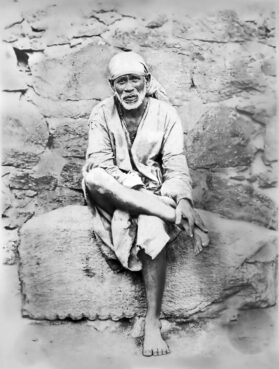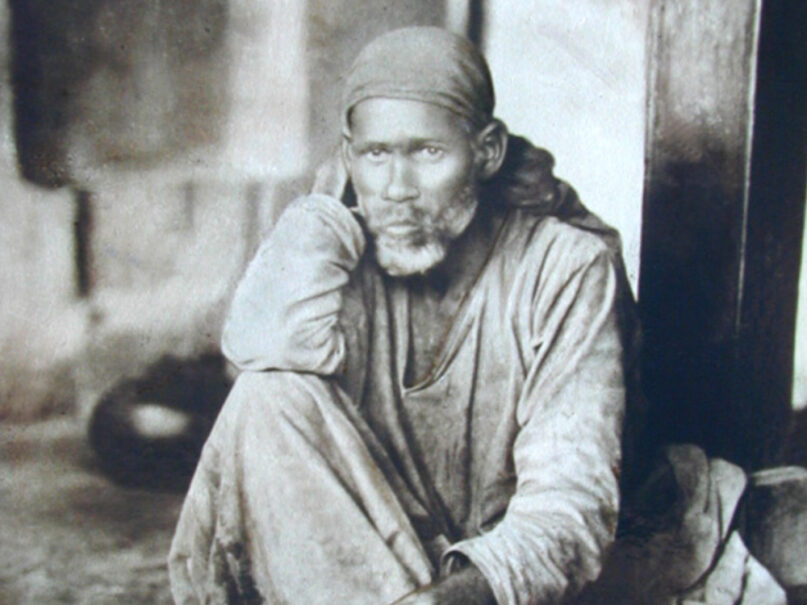(RNS) — In recent years, India has seen growing tensions — and sometimes violence — between Hindus and the country’s large Muslim minority, often stoked by some of the country’s numerous political parties and extremist groups from both religions. The fraught relations between the two groups trace back centuries, from the persecution of Hindus and Sikhs by some Muslim rulers, to tensions perpetuated by the British in colonial India and the partition of India and Pakistan in 1947.
But in the past, devotion united Indians of both faiths, as the story of a late-19th century and early 20th century Indian religious leader and his followers reminds us.
Shirdi Sai Baba’s real name, birthdate and origins are unknown, but according to his Hindu and Muslim followers, he was born in the 1830s and followed an ascetic lifestyle from an early age, living under a neem tree and spending long hours in meditation. He wore Islamic garb but offered prayers at both the local mosque and temple.
Shirdi Sai Baba’s influence was monumental in shaping Indian spirituality. Sufi mystics praised how his idea of seeing divinity in all beings corresponded with their core philosophy and that of Advaita Hinduism, which preaches non-dualism between living beings and the Divine. Sai Baba influenced a Zoroastrian mystic, Meher Baba, who credited him with articulating a philosophy of looking inward for realization.
Sai Baba was a proponent of “bhakti,” a feeling of intimate personal connection, and urged his followers to surrender themselves to the divine without getting caught up in the orthodoxy of rituals.
He encouraged both his Hindu and Muslim followers to read their respective holy texts to become the best versions of themselves. He rejected material offerings and spent his life in contemplation, eschewing orthodoxy. His life was chronicled by his followers in a book called “Shri Sai Satcharitra,” which was an important text to members of my family, a number of whom were devotees of Shirdi Sai Baba.

Shirdi Sai Baba in an undated image. Photo courtesy Wikimedia/Creative Commons
Shirdi Sai Baba preached the oneness of both Hindu and Muslim teachings by highlighting how both taught their followers to find the true realized versions of themselves. After his death in 1918, a Hindu temple in Shirdi was built that welcomed both Hindu and Muslim (and Zoroastrian) devotees.
Years later, a Hindu religious leader named Satya Sai Baba claimed to be an incarnation of Shirdi Sai Baba and preached the idea of “loving all and serving all,” a philosophy that drew hundreds of thousands of non-Indian followers from around the world. In fact, Satya Sai Baba became far more remembered in the West, particularly after influencing Americans such as Isaac Tigrett, the co-founder of Hard Rock Cafe, and the musician Alice Coltrane.
While Satya Sai Baba became an international celebrity, Shirdi Sai Baba was known more to locals and members of the Indian diaspora who were familiar with his life and teachings. For years, including in the decades after partition, Hindus and Muslims worshipped at the temple in Shirdi, and at least to a limited degree, Hindus and Muslims outside of India would attend ceremonies honoring his life or visit temples created in his honor.
Shirdi Sai Baba’s teachings brought together Hindus and Muslims of different castes as well. During times when lower-caste Hindus and lower-caste Muslims were frequently marginalized by upper-caste Hindus and upper-caste Muslims (known as Ashrafs), Shirdi Sai Baba rejected caste as anything grounded in religion.
In recent years, however, the co-worshipping has diminished. Today, the vast majority of Shirdi Sai Baba devotees are Hindus, a product of a number of factors, including increased hostilities between followers of both faiths, calls by Indian Muslims to reject any reverence to any religious figures or deities except Allah, and a generational shift in how both Hindus and Muslims now practice their religions.
Still, Shirdi Sai Baba left an indelible mark on both the syncretic nature of Indian spirituality and communal harmony. His life and words could prove to be an inspiration to those seeking to rebuild the bridges between followers of both faiths.
(Murali Balaji is a journalist and a lecturer at the Annenberg School for Communication at the University of Pennsylvania. His books include “Digital Hinduism” and “The Professor and the Pupil,” a political biography of W.E.B. Du Bois and Paul Robeson. The views expressed in this commentary do not necessarily reflect those of Religion News Service.)





